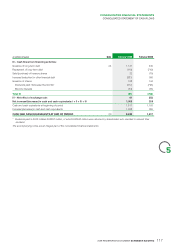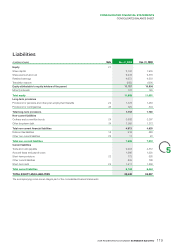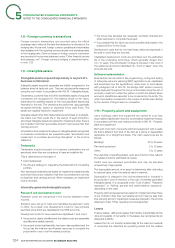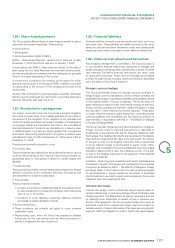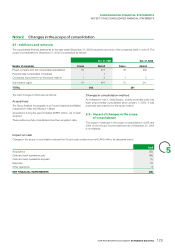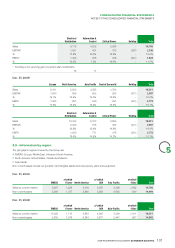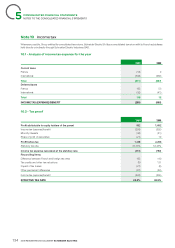APC 2009 Annual Report Download - page 128
Download and view the complete annual report
Please find page 128 of the 2009 APC annual report below. You can navigate through the pages in the report by either clicking on the pages listed below, or by using the keyword search tool below to find specific information within the annual report.
2009 REGISTRATION DOCUMENT SCHNEIDER ELECTRIC126
CONSOLIDATED FINANCIAL STATEMENTS
5NOTES TO THE CONSOLIDATED FINANCIAL STATEMENTS
1.13 - Inventories and work in process
Inventories and work in process are stated at the lower of cost
(generally determined by the weighted-average cost method) and
estimated net realizable value.
Net realizable value corresponds to the estimated selling price net of
remaining expenses to complete and/or sell the products.
Impairment losses on materials are recognised in “Cost of sales”
and on fi nished products in “Selling, general and administrative
expenses”.
The cost of work in process, semi-fi nished and fi nished products
includes direct materials and labour costs, subcontracting costs,
production overheads based on normal capacity utilisation rates
and the portion of research and development costs related to the
production process (corresponding to the amortisation of capitalised
projects in production and product and range maintenance costs).
1.14 - Trade accounts receivable
An allowance for doubtful accounts is recorded when it is probable
that receivables will not be collected and the amount of the loss
can be reasonably estimated. Doubtful accounts and the related
allowances are identifi ed and determined based on historical loss
experience, the age of the receivables and a detailed assessment
of related credit risks. Once it is known with certainty that a doubtful
account will not be collected, the doubtful account and the related
allowance are written off to the income statement.
Accounts receivable in more than one year are discounted in cases
where the discounting adjustment is material.
1.15 - Assets held for sale
Assets held for sale are no longer depreciated and are recorded
separately in the balance sheet under “Assets held for sale” at the
lower of amortised cost and net realizable value.
1.16 - Deferred taxes
Deferred taxes, corresponding to temporary differences between the
tax basis and reporting basis of consolidated assets and liabilities,
are recorded using the liability method. Deferred tax assets are
recognised when it is probable that they will be recovered at a
reasonably determinable date.
Future tax benefi ts arising from the utilisation of tax loss carryforwards
(including amounts available for carryforward without time limit)
are recognised only when they can reasonably be expected to be
realized.
Deferred tax assets and liabilities are not discounted. Deferred tax
assets and liabilities that concern the same unit and are expected
to reverse in the same period are netted off.
1.17 - Cash and cash equivalents
Cash and cash equivalents presented in the balance sheet consist
of cash, bank accounts, term deposits of three months or less
and other liquid marketable securities. Substantially all marketable
securities represent short-term instruments that can be easily
converted into a determinable cash amount, such as commercial
paper, mutual funds and equivalents. In light of their nature and
maturities, these instruments carry virtually no risk of impairment.
The Group treats them as cash equivalents.
1.18 - Schneider Electric SA shares
Schneider Electric shares held by the parent company or by fully
consolidated companies are measured at cost and deducted from
equity. They are held at their acquisition price until sold.
Gains and losses on the sale of treasury stock are recognised in
equity, net of tax.
1.19 - Pensions and other post-employment
benefit obligations
Depending on local practices and laws, the Group’s subsidiaries
participate in pension, termination benefi t and other long-term benefi t
plans. Benefi ts paid under these plans depend on such factors
as seniority, compensation levels and payments into mandatory
retirement programmes .
Defined contribution plans
Payments made under defi ned contribution plans are recorded in the
income statement, in the year of payment and are in full settlement
of the Group’s liability. In most countries, the Group participates
in mandatory general plans that are accounted for as defined
contribution plans.
Defined benefit plans
The present value of defi ned benefi t obligations is determined using
the projected unit credit method.
Charges recognised in profi t or loss are recorded as a deduction
from operating profi t.
The amount recognised in the balance sheet corresponds to the
present value of the obligation, adjusted for unrecognized past
service cost and reduced by the fair value of plan assets at the
balance sheet date.
If the plan has a surplus (i.e. the fair value of plan assets is greater
than the present value of the obligation, as adjusted for unrecognized
past service cost), the recognised asset is limited to the present value
of available refunds and reductions in future contributions to the plan.
Changes resulting from periodic adjustments to actuarial assumptions
regarding general fi nancial and business conditions or demographics
(i.e., changes in the discount rate, annual salary increases, return on
plan assets, years of service, etc.) as well as experience adjustments
are immediately recognised in the Group’s balance sheet and as a
separate component of equity in “Other reserves”.
Other commitments
Provisions are booked to cover the cost of providing healthcare
benefi ts for certain retired employees in Europe and the United
States. The accounting policies applied to these plans are similar to
those used to account for defi ned benefi t pension plans.
The Group also records for all its subsidiaries an obligation for
seniority-related benefi ts (primarily long service awards in its French
subsidiaries). Actuarial gains and losses on these benefi t obligations
are recognised directly in profi t or loss.



